Parliament of South Africa
| Parliament of the Republic of South Africa List
| |
|---|---|
| 26th South African Parliament | |
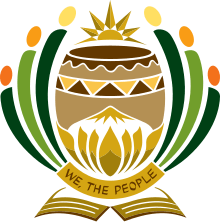 | |
| Type | |
| Type | |
| Houses |
National Assembly National Council of Provinces |
| Leadership | |
| Structure | |
| Seats |
490 90 National Council 400 National Assembly |
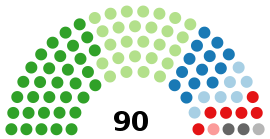 | |
National Council of the Provinces political groups | |
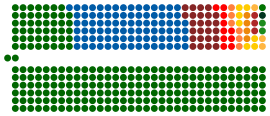 | |
National Assembly political groups |
Other parties |
| Meeting place | |
.jpg) | |
|
Houses of Parliament, Cape Town Western Cape, South Africa | |
| Website | |
|
www | |
 |
|---|
| This article is part of a series on the politics and government of South Africa |
|
Related topics |
The Parliament of South Africa is South Africa's legislature and under the country's current Constitution is composed of the National Assembly and the National Council of Provinces.[1]
It has undergone many transformations as a result of the country's tumultuous history. From 1910 to 1994, it was elected mainly by South Africa's white minority, before the first elections with universal suffrage were held in 1994.
History
Before 1910
The predecessor of the Parliament of South Africa, before the 1910 Union of South Africa, was the bicameral Parliament of the Cape of Good Hope. This was composed of the House of Assembly (the lower house) and the Legislative Council (the upper house). It dated back to the beginnings of Cape independence in 1853, and was elected according to the multi-racial Cape Qualified Franchise system, whereby suffrage qualifications were applied equally to all males, regardless of race.
The buildings of the Cape Parliament went on to house the Parliament of South Africa, after union.[2][3]
1910 to 1961
When the Union of South Africa was established in 1910,[4] the Parliament was bicameral and consisted of the King or the Queen, the Senate, and the House of Assembly (known in Afrikaans as the Volksraad).
- The King (from 1952, the Queen of South Africa) was represented by the Governor-General.
- The Senate consisted of senators nominated by the four provinces, and by the Governor-General, initially for a period of ten years. The number of senators was changed from time to time. The Senate was chaired by a President of the Senate chosen by the senators from among themselves.
- The House of Assembly consisted of members who were directly elected by the voters. Each MP represented an electoral district (constituency), and most of them were elected on the basis of their political party. The number of constituencies and parliamentary seats was increased from time to time, in line with increases in the population. The House was chaired by a Speaker chosen by the MPs from among themselves.
- Only white men could be senators or MPs.
- The franchise (right to vote) was originally granted to white men in all four provinces, to black men in the Cape Province and Natal, and to Coloured men in the Cape Province – in all cases, the minimum age was 21 years.
The composition of Parliament was changed by constitutional amendments from time to time:
- From 1930, white women had the vote, and the right to serve as senators and MPs, on the same basis as white men.
- In 1934, Parliament was declared "the sovereign legislative power in and over the Union".[5]
- From 1937, black voters were separated from the other races – in the Senate they were represented by four elected senators (two for the Cape, one for Natal, one for the Orange Free State and Transvaal), and in the House of Assembly by three "native representative" MPs elected in separate black constituencies.[6]
- From 1950, white voters in South West Africa, which was under South African administration at that time, were represented by four senators and six MPs.
- From 1957, Coloured voters were separated from the whites – in the Senate they were represented by separate senators, and in the House of Assembly by MPs elected in separate Coloured constituencies.[7] To pass this amendment in the face of strong opposition (and two Supreme Court rulings), prime minister Johannes Strijdom had to enlarge the Senate and appoint enough pro-government senators to get the two-thirds majority he needed to force through the constitutional change.[8]
- Representation of black voters was ended in 1960.
- Voting age was lowered from 21 to 18 in 1960.
In a referendum held in 1960, a small majority of the white voters approved the conversion of the country from a Realm or Dominion of the British Commonwealth to a republic.
1961 to 1984
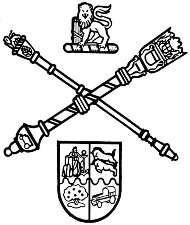
The Republic of South Africa was established in 1961. The only change made to the composition of the Parliament was the substitution of the State President for the Queen.[10] A few significant changes were made later:
- Coloured representation was ended in 1968, leaving both the Senate and the House of Assembly representing white voters only.
- South West Africa ceased to be represented in Parliament from 1977.[11]
- The Senate was abolished in 1981, changing Parliament to a unicameral legislature.
1984 to 1994
A new Constitution, introduced in 1984, re-enfranchised the Coloured population (women as well as men), and enfranchised the Indian population. It retained the existing House of Assembly for whites, and established a House of Representatives to represent the Coloureds, and a House of Delegates for the Indians, making Parliament a tricameral legislature. Blacks continued to be excluded.
- Each house consisted of members elected to represent constituencies, plus a few additional members elected by the MPs, and some nominated by the State President.
- Each house legislated on "own affairs" exclusive to its own race group, and they legislated jointly on "general affairs" affecting all races.[12] In practice, the House of Assembly, which had more MPs than the other two houses combined, continued to dominate the legislature.
- Each house was chaired by a chairman elected by its members from among themselves. They were co-ordinated by a Speaker of Parliament, elected by the members of all three houses in a joint sitting.
- The existing House of Assembly, elected in 1981, was deemed to have been re-elected in 1984, to co-ordinate its term of office with those of the two new houses. However, this was later overturned by the Supreme Court, and a separate election had to be held for the House of Assembly in 1987. The House elected in 1987 was then dissolved with the other houses in 1989.
The black majority were still disfranchised, and the new system lacked legitimacy even among the Coloureds and Asians, many of whom boycotted elections. In a referendum held in 1992, 68.73% of (only white) voters approved the reform process that effectively ended Apartheid. In late 1993, one of the last pieces of legislation passed by the Tricameral Parliament was the Interim Constitution, which took effect on 27 April 1994, the same day as the first non-racial elections.
Since 1994
A new interim constitution, introduced in 1994 after four years of negotiation, finally introduced all-race democracy and enfranchised men and women of all races on equal terms, the minimum age remaining 18 years. Parliament was reconstituted to consist of a Senate and a National Assembly.
- The Senate consisted of 90 senators, ten nominated by each of the nine provinces. It was chaired by a President of the Senate elected by the senators from among themselves.
- The National Assembly consists of 400 members, elected by voters on a proportional representation/party list system. There are no electoral districts, and each party is allocated a number of seats proportionate to the percentage of the votes it receives across the country. It is chaired by a Speaker elected by the MPs from among themselves.
- In 1997 the current Constitution of South Africa came into force, in which the Senate was replaced by a 90-member National Council of Provinces (NCOP), made up of a 10-member delegation from each province (six delegates elected by the provincial legislature, the Premier and three other members of the provincial legislature). The NCOP is chaired by a Chairperson elected by the members from among themselves.
The parliamentary system uses proportional representation, with voters voting for political parties rather than for candidates. Proportional representation allows for smaller parties to have a chance of acquiring seats in parliament, although these parties often combine in order to have a stronger voice within the political system, especially against the ANC. The Independent Electoral Commission is charged with keeping elections fair, regular, and equal. Parties submit closed lists of candidates to the IEC, and the IEC fills the seats allotted to individual parties using the candidate lists after election results come in. The electoral system has seen little corruption since 1994. An average of 30% of Africans have admitted to giving bribes in exchange for public services between 2015 and 2016, while only 15% of South Africans have admitted to this.[13]
Major political parties in parliament
African National Congress: The ANC was created in 1912, but became the leading political party after the end of apartheid in 1994. Its main platform rests on racial equality and eradicating the socioeconomic classes which are often based on race. The ANC has been considered a party for native South Africans, especially before 2009 when party leader President Zuma faced multiple accusations regarding corruption, particularly using public funds for his own purposes.[14] The economic struggle of South Africa as well as the police brutality have both been blamed on the ANC. Currently the ANC holds 249 seats in parliament. Support for the ANC went down between the 2009 and the 2014 elections, with violent protests erupting all over the country in response to the allegations of corruption within the ANC.
Democratic Alliance: The DA formed when New National Party and Federal alliance joined the Democratic Party in 2000 to form an alliance. The DA is the opposition party and has been traditionally supported by South Africa's minority communities (white, 'coloured' and Indian). In more recent years the party has attempted to win votes from black South Africans and as a result black support for the DA has risen over the past several years, going from 1% to 6%.[15] The DA is a liberal formation that favours free market policies. Although the party has its roots in the democratic opposition to apartheid, the party has struggled to evade a perception that is a white-dominated organisation. The DA was allotted 89 seats in parliament after the 2014 general election.
Economic Freedom Fighters: The EFF emerged 8 months before the 2014 general election and took a startling 25 seats in parliament. The EFF is South African revolutionary socialist political party, advocating for land expropriation and for an end to corruption within parliament. The EFF has been widely accused of inflammatory hate speech against White and Indian South Africans.
Because the ANC has such a large majority of parliament, smaller parties are constantly forming alliances and coalitions in order to act as a stronger opposition to the ANC-run legislative and executive branches.
Seat of Parliament
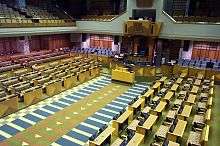
Parliament sits in Cape Town, even though the seat of government is in Pretoria. This dates back to the foundation of the Union, when there was disagreement among the four provinces as to which city would be the national capital. As a compromise, Cape Town was designated the legislative capital, Bloemfontein the judicial capital, and Pretoria the administrative capital. The African National Congress (ANC) government has proposed moving Parliament to Pretoria, arguing that the present arrangement is cumbersome as ministers, civil servants and diplomats must move back and forth when Parliament is in session.
However, many Capetonians have spoken out against such a move, accusing the ANC of trying to centralise power. Under the Constitution, there is provision for Parliament to sit elsewhere than Cape Town on grounds of public interest, security or convenience and Parliament is permitted to provide in its rules and orders for sittings outside Cape Town. Rule 24 of the National Assembly Rules accordingly allows the Speaker to direct that the House will sit at 'a place other than the Houses of Parliament in Cape Town' after consulting the Leader of the House and the Chief Whip of each party represented in the House. Rule 21 of the rules of the National Council of Provinces allows the Council to pass a resolution providing for it to sit elsewhere.
List of Parliaments
Parliaments of the Union
- 1st South African Parliament (1910–1915) – majority party : South African Party
- 2nd South African Parliament (1915–1920) – majority party : South African Party
- 3rd South African Parliament (1920–1921) – majority party : South African Party
- 4th South African Parliament (1921–1924) – majority party : South African Party
- 5th South African Parliament (1924–1929) – majority party : National Party
- 6th South African Parliament (1929–1933) – majority party : National Party
- 7th South African Parliament (1933–1938) – majority party : United Party
- 8th South African Parliament (1938–1943) – majority party : United Party
- 9th South African Parliament (1943–1948) – majority party : United Party
- 10th South African Parliament (1948–1953) – majority party : National Party
- 11th South African Parliament (1953–1958) – majority party : National Party
- 12th South African Parliament (1958–1961) – majority party : National Party
Parliaments of the Republic
- 1st Parliament of the Republic of South Africa (1961–1966) – majority party : National Party
- 2nd Parliament of the Republic of South Africa (1966–1970) – majority party : National Party
- 3rd Parliament of the Republic of South Africa (1970–1974) – majority party : National Party
- 4th Parliament of the Republic of South Africa (1974–1977) – majority party : National Party
- 5th Parliament of the Republic of South Africa (1977–1981) – majority party : National Party
- 6th Parliament of the Republic of South Africa (1981–1984) – majority party : National Party
- 7th Parliament of the Republic of South Africa (1984–1987) – majority party : National Party
- 8th Parliament of the Republic of South Africa (1987–1989) – majority party : National Party
- 9th Parliament of the Republic of South Africa (1989–1994) – majority party : National Party
- 1st Democratic Parliament of the Republic of South Africa (1994–1999) – majority party : African National Congress
- 2nd Democratic Parliament of the Republic of South Africa (1999–2004) – majority party : African National Congress
- 3rd Democratic Parliament of the Republic of South Africa (2004–2009) – majority party : African National Congress
- 4th Democratic Parliament of the Republic of South Africa (2009–2014) – majority party : African National Congress
- 5th Democratic Parliament of the Republic of South Africa (2014–present) - majority party : African National Congress
See also
References
- ↑ Constitution of the Republic of South Africa, 1996, s. 42 Archived 13 April 2014 at the Wayback Machine.
- ↑ The old Cape House, being pages from the history of a legislative assembly, Ralph Kilpin, T.M Miller, Cape Town, 1918
- ↑ The Houses of Parliament, Cape Town, Andrew Cusack, 3 November 2009
- ↑ South Africa Act 1909
- ↑ Status of the Union Act 1934
- ↑ Representation of Natives Act 1936
- ↑ Separate Representation of Voters Act 1956
- ↑ Senate Act 1955
- ↑
- ↑ Republic of South Africa Constitution Act 1961
- ↑ SOUTH AFRICA Date of Elections: November 30, 1977, Inter-Parliamentary-Union
- ↑ Republic of South Africa Constitution Act 1983
- ↑ "Why is corruption getting worse in South Africa? | Corruption Watch". Corruption Watch. 2014-01-17. Retrieved 2016-05-06.
- ↑ "Can we blame you now, President Zuma? | Corruption Watch". Corruption Watch. 2015-04-07. Retrieved 2016-05-06.
- ↑ Sapa, TimesLIVE,. "South Africa election results 2014". Times LIVE. Retrieved 2016-05-06.
- South Africa Act 1909
- Constitution of the Republic of South Africa 1961
- Constitution of the Republic of South Africa 1983
- Constitution of the Republic of South Africa 1993
- Constitution of the Republic of South Africa 1996
- Kahn, E. (1961). The New Constitution.
- Kruger, D.W. (1969). The Making of a Nation.
- May, H.J. (1949). The South African Constitution.
External links
| Wikisource has original works on the topic: Acts of the Parliament of South Africa |
| Wikimedia Commons has media related to Parliament of South Africa. |